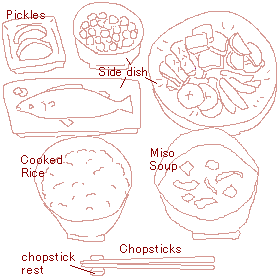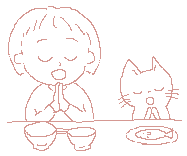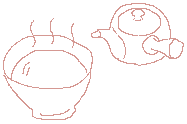Japanese home cooking
Sushi, Tempura, and Sukiyaki are popular Japanese food. However, the Japanese people do not eat these types of dishes everyday.

We say "eat rice" to have a meal in Japan. Rice is a main food in a Japanese and it is eaten with miso soup, some side dishes, and pickles. Japanese cooking is rarely very spicy and food is seasoned lightly. Dashi (soup stock) is used a lot in Japanese cooking. Vegetables and so on are then boiled in the dashi and other seasonings add.
Japanese Table manners

We have a custom to say "itadakimasu" before a meal and "gochisousama deshita" after a meal by joining our palms together with thanks for food in Japan.

Bowl [chawan]: It is acceptable to hold either a rice bowl or other bowl in your hand and eat directly from that in Japan. Put the bowl on your left hand (in the case of being right-handed) and keep it from moving with your thumb. For bowls with soup in them, drink directly from the bowl. You can also pick the little bowls up to eat from. - refer to "Living in Japan (ALC Press)"
Chopsticks [hashi]: Hold the chopsticks about 1/3 of the way down from the top with relax and take a gentle hold. Lay the bottom chopstick against your ring finger and place the other one between thumb, index finger, and middle finger. Try to move the top chopstick. - refer to "Living in Japan (ALC Press)"
Taboos

1 using one's chopsticks to take some food from someone else's chopsticks.

2 Sticking chopsticks upright in a bowl of rice.
Drink tea after meals

We are in the habit of drinking houji-cha (roasted green tea) after meals in Japan. We generally use one's rice bowl for drinking tea. As tea remove glutinous rice which cling to bowl, we easy to wash bowl. Tea also remove some bits of food stuck to one's teeth. As compared with other tea, green tea is known to include a lot of vitamin C and is considered to be very good for the health.